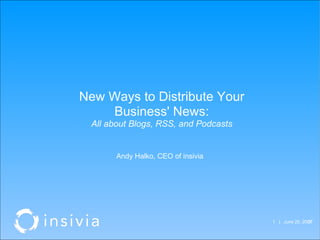Emarketing Techniques Blogs Rss Feeds And Podcasts By Andy Halko Of Insivia 1192490387226539 1
- 1. | June 25, 20 07 New Ways to Distribute Your Business' News: All about Blogs, RSS, and Podcasts Andy Halko, CEO of insivia
- 2. A blog is a website where entries are written in chronological order and displayed in reverse chronological order. Wikipedia | June 25, 2007
- 3. Why use a blog in the corporate environment ? Relate to the reader. Distribute information quickly. Create a following. Establish expertise. Improve Search Engine Optimization Stay with the Trends | June 25, 2007
- 4. What should my blog content be? Developing your subject matter : defining your goals. Following the Golden Rules : keep it interesting, keep it focused. Checking the examples : Meet the Bloggers, finefrog, GoDaddy Putting it together : defining your corporate blog branding strategy. | June 25, 2007
- 5. What technology should I use to start my blog? Branded versus non-branded blog sites : the right integration Third-Party sites and software or integrated : the right software Workflow : the right procedures | June 25, 2007
- 6. RSS ( Really Simple Syndication) is a way to distribute or syndicate information in a standard format that allows third-party softwares to obtain those feeds of information and uniformly understand the structure of that information so they can work with it. | June 25, 2007 Website 1 Content Website 2 Content Website 3 Content Website 4 Content Standard Information Format RSS RSS Reader displays information from multiple sites.
- 7. How can RSS fit into the corporate environment ? External to Internal Employees Get customer, competitive, industry information to their desktops. Internal to External Audience Provide news, deals, updates, and much more to customers. Internal to Internal Employees and organizations sharing information in one place. | June 25, 2007
- 8. What tools can I use to read RSS feeds ? From the specific to the personalized Google's personalized pages (http://www.google.com/ig) Feed Gator Insivia's company intranet software | June 25, 2007
- 9. What kinds of feeds can I create and how do I create them? Reaching great numbers: news and information Using marketing opportunities and providing information in an inventive way: coupons, software updates, policy updates, job openings | June 25, 2007
- 10. A podcast is the use of both blogs and RSS specifically relating to audio and video media . | June 25, 2007
- 11. How do podcasts fit into the corporate environment ? Audio and video media take the presenting online information to the next level. Adding interest : adding a personal touch and a human element Visualizing it: making a message more impactful by appealing to different senses | June 25, 2007
- 12. Why podcast in the corporate environment ? | June 25, 2007 Relate to the reader. Distribute information quickly. Create a following. Establish expertise. Improve Search Engine Optimization Stay with the Trends
- 13. What should my podcast content include? Developing your subject matter : defining your goals. Following the Golden Rules : keep it interesting, focused ŌĆö think first. Checking the examples : Meet the Bloggers, podcast.com Putting it together : defining your corporate podcast branding strategy. | June 25, 2007
- 14. What should I consider in my podcast strategy ? Quality Branding Structure and organization Podcast subjects and missions Guidelines
- 15. What technology will I need to podcast ? Recording: quality counts Publishing: using both blogs and RSS with tools like iTunes
- 16. Thank you! Questions? | June 25, 2007
















